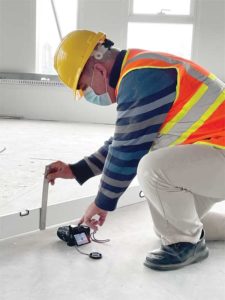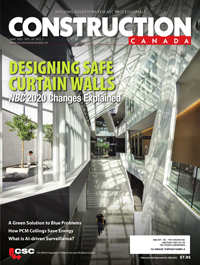Concrete chronicles: Achieving floor flatness and levelness

The current method used by architects, engineers, and specifiers for specifying concrete placement to higher FF/FL values to account for natural changes to smoothness and evenness is misguided, since the statistical nature of the ASTM E1155 measurement procedure results in greater deviation when higher values are specified. A concrete surface specified to FF50/FL35 will decrease in uniformity to a greater per cent difference than a floor specified to FF25/FL20, which is considered as standard achievable concrete finishing without using special installation techniques.
While it is possible to improve concrete FF stability through design, curing improvement, and laser screeding, secondary FF testing timing would be required closer to the time of floor placement to assess deviation over time. The measurement at threshold (within 72 hours of concrete placement) and again via local FF testing (within seven to 14 days of flooring installation) would identify variability over time and allow for future design alterations based on stability performance. However, as long as the FF is measured in Division 03 at the time of placement and the straight edge method is employed at the time of floor covering installation, the industry will continue to search in the dark for solutions. Decades have proven that it is difficult to solve for X when speaking in two incompatible languages. The NFCA “Best Practice for Measuring Substrate Flatness for Flooring Installation” is the first concerted attempt to bring light to this issue.
Conclusion
Concrete floors, found in a myriad of structures with varying performance requirements, epitomize a realm where meticulous design and craftsmanship intersect. Conducting this symphony of elements, the concrete mix, the often-overlooked curing process, and the precision of finishing orchestrate the creation of not just floors, but functional canvases. Yet, in this complex dance, FF and FL, harmonizing performance and esthetics provide something to hold on to. In a world laden with benchmarks and blurred responsibilities, these factors become the silent architects of quality and contingency protections. FF, ensuring the smooth operation of machinery, and FL, dictating stability and fluidity, demand a choreography of planning and execution. Picture a canvas: the base is level, the mix design a carefully chosen palette, and the curing process an artful stroke. This, coupled with meticulous control in placement and finishing, forms the symphony. However, the challenge lies in the discord between measurement methods, a dissonance the NFCA’s best practice aims to harmonize. Until a unified language emerges, the pursuit of overcoming these challenges continues—a quest for simplicity in the intricate work of concrete construction.
Authors
Chris Bennett, iSCS, CDT, is the founder of Bennett Build, an industry-recognized leader in concrete consulting and owner representation. His portfolio includes the longest history of helping project teams in commercial internal curing in North America. Bennett has also helped improve continuing education in concrete by facilitating such programs as The National Concrete and Corrosion Symposium (NCCS), Concrete North, and various hands-on reality labs with institutions such as University of Alberta, the University of Akron NCERCAMP, the Construction Specifications Institute (CSI), and the International Society for Construction Sciences. His work has been featured at Dreamforce, Construct, Praxis!, World of Concrete, and more. He can be reached at chris@bennettbuild.us.
James Longo, iSCS, is the principle of Specified Surfaces, a U.S. based specialty distributor in the flooring and concrete industry. With more than 30 years industry experience spanning installation, manufacturing, consulting, distribution, and sales, Longo brings a 360-degree view of the challenges and solutions to delivering consistent, warranted flooring installation systems. Specified Surfaces works directly with professional flooring contractors, owners, A/D teams, and general contractors in the U.S. and Canada. Longo can be reached at
jlongo@specifiedsurfaces.com.
Keith Robinson, RSW, FCSC, FCSI, is a retired architectural technologist and specifier based in Edmonton, Alta. Robinson also instructs courses for the University of Alberta, acts as an advisor to several construction groups, and sits on many standards review committees for ASTM and the National Fire Protection Association (NFPA), and the A21–Best Practices for Measuring Substrate Flatness for Floor Covering Installations. He can be reached at krobinson@dialogdesign.ca.







